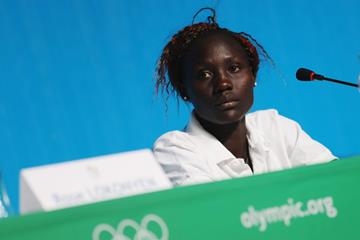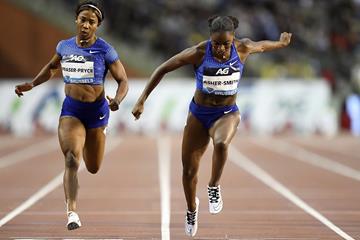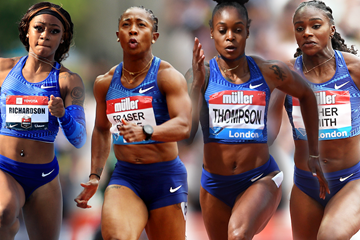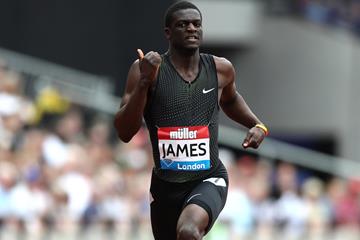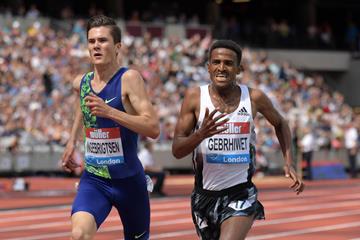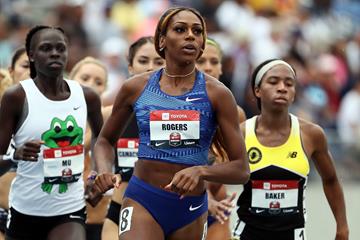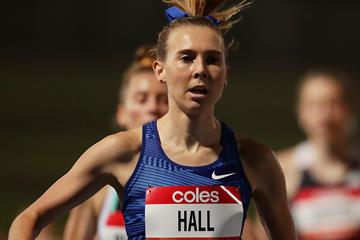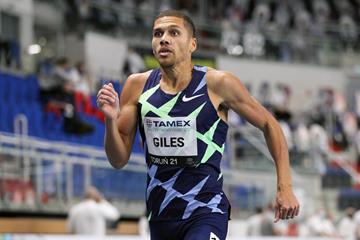 Countdown
Countdown
 Countdown
Countdown
The 1500m is the marquee middle-distance running event. Athletes compete by running three and three-quarters laps of a standard outdoor 400m track and the winner is the athlete who crosses the finish line first.
In the USA and Great Britain, the event was originally run over a distance of 1609m (one mile)
The event later transitioned to 1500m and is also known as ‘the metric mile’
The men’s 1500m has been an Olympic event since 1896 and the women’s event was introduced to the Games in 1972
At major championships, the 1500m schedule typically consists of heats, semifinals and a final
Sebastian Coe, the President of World Athletics, is the only athlete to achieve back-to-back Olympic gold medals in the men’s 1500m
Faith Kipyegon won consecutive Olympic titles in the women’s event, in Rio and Tokyo
The 1500m is a middle-distance running event that requires a huge amount of speed, strength and endurance. It also demands a balance of aerobic and anaerobic conditioning.
The first pre-recognition women’s 1500m world record was set by Soviet athlete Anna Mushkina, with 5:18.2 in August 1927. From then until 1962, athletes from only three countries broke the record: six from the Soviet Union, two from Great Britain and one from New Zealand. New Zealand’s Marise Chamberlain was the last pre-recognition record holder, with a time of 4:19.0.
British runner Anne Smith set the first recognised women’s 1500m world record, with 4:17.3 in June 1967. The first sub-four-minute time was achieved by Soviet athlete Tatyana Kazankina in June 1976, when she ran the distance in 3:56.0.
Since then, the record has been beaten six times, including twice by Kazankina herself. The current world record-holder, Kenya’s Faith Kipyegon, has also improved the record twice – first to 3:49.11 in June 2023 and then to 3:49.04 in Paris in July 2024.
The first pre-recognition men’s 1500m world record was set by France’s J. Borel in 1892, with a time of 4:24. The final pre-recognition record came in June 1912, when US athlete Abel Kiviat ran 3:56.
The first recognised men’s 1500m world record was also set by Kiviat, who beat his previous pre-recognition time with 3:55.8, also in June 1912. Kiviat held the record for five years until Swedish athlete John Zander ran 3:54.7 in August 1917.
Between 1930 and 1960, the record was improved 22 times. Then, in September 1960, Australian runner Herb Elliott finished in 3:35.6. He then held the record for seven years.
Between 1967 and 1995, the world record was only broken 11 times, showing just how difficult it had become. In July 1995, Algerian athlete Noureddine Morceli set a record of 3:27.37. This was then broken by Moroccan runner Hicham El Guerrouj in July 1998, when he ran 3:26.00.
El Guerrouj has held the record ever since. Some athletes have come close, such as Bernard Lagat, who was just 0.34 of a second slower, but so far it has proven to be unbeatable.
The world indoor 1500m records are held by Ethiopia’s Gudaf Tsegay (3:53.09 in 2021) and Norway’s Jakob Ingebrigtsen (3:30.60 in 2022).
Many famous athletes have competed in the 1500m over the years. Notable men’s runners include the ‘Flying Finn’ Paavo Nurmi, Australia’s Herb Elliott, Kenyan Kip Keino and back-to-back Olympic gold medallist (and World Athletics President) Sebastian Coe.
Notable women’s 1500m runners include Bahrain’s Maryam Yusuf Jamal, three-time World Championships medallist Sifan Hassan of the Netherlands, and three-time world and two-time Olympic champion Faith Kipyegon of Kenya.

The 1500m is a middle-distance running event, with elite athletes usually achieving a time of under four minutes. While this doesn’t sound like a long time, running this quickly for this long can have a huge impact on your body and mind. As a result, 1500m athletes need to possess a unique blend of strength, speed, endurance and mental toughness.
A 1500m race is run by completing three and three-quarter laps of a standard 400m track. There’s a specific 1500m running technique, which can be broken down into several phases:
Athletes begin the race in a bunched standing start and in a standing position. The call of, ‘On your marks, set,’ followed by the firing of the pistol signals the start of the race.
Immediately after the start of the race, athletes move across to the inside lane to ensure they cover less distance and keep pace with the pack. Athletes run fast, but not at top speed, as they conserve energy for the final lap.
Athletes attempt to pull away from the competition while also holding on to some energy and making sure they don’t burn out too quickly. During this lap, athletes will gradually pick up the pace.
For the final lap, athletes will – especially in the last 200 to 300 metres – typically increase their speed for a strong finish, using the energy they’ve conserved during the first couple of laps. This is the big final push and it’s where many races are won, especially in a hotly-contested event like the 1500m.
The 1500m rules are simple to understand and fair.
Athletes start in a bunched standing position and can immediately break for the inside lane.
If a runner starts the race before the starting gun it’s considered a false start. If there is a false start, that runner is immediately disqualified.
Athletes may be disqualified for obstructing other runners, impeding the progress of other runners or stepping out on the inside side of the track.
The winner is the athlete who crosses the finish line first.
There are no wind considerations in the 1500m event.
A 1500m race is typically run by completing three and three-quarter laps of a standard 400m track.
The 1500m is categorised as a middle-distance race, with elite athletes usually finishing the race in less than four minutes. Runners must pace themselves and not attempt to sprint for the entire duration, as this will likely lead to burnout and a sub-optimal time.
There are several things to bear in mind for efficiently running a 1500m race:
Set a target finishing time
Break this target time down into sections, so you know how long each lap should take
Conserve energy during the early stages of the race and build towards the kick in the final lap, when you increase speed to push to cross the finish line
Your first lap should be your slowest and your last should be your quickest
Try to position yourself strategically within the pack, while avoiding getting boxed in
Practice pacing during training to help accurately gauge your own pace
Incorporate strength training into your training regime
During the build-up to a 1500m race, you need to make sure you undertake the right mental and physical preparations:
Establish a training plan that includes middle-distance running, sprinting and strength training
Make sure you incorporate rest days into your routine to help with recovery and lessen the risk of injury
Incorporate interval training into your workout to build stamina and prepare for the final kick in a race
Ensure you get the right amount of sleep and eat a balanced diet
Always stay hydrated
Do what you can to maintain a positive attitude – picture victory and focus on your strengths
Athletes can use spikes in the 1500m. Typically, athletes will use long-distance spikes because they’re designed to be used over longer distances. Meanwhile, sprint spikes are intended for use over short distances and they’re designed to keep an athlete on the balls of their feet.
Middle-distance running is any running event between 800 metres and 3000 metres – that means the 1500m falls within the middle-distance category.
 POR
POR
 NED
NED
 KEN
KEN
 FRA
FRA
 USA
USA
 KEN
KEN
 KEN
KEN
 MAR
MAR
 AUS
AUS
 GER
GER
 KEN
KEN
 AUS
AUS
 KEN
KEN
 USA
USA
 ETH
ETH
 IRL
IRL
 AUS
AUS
 GBR
GBR
 ETH
ETH
 USA
USA
